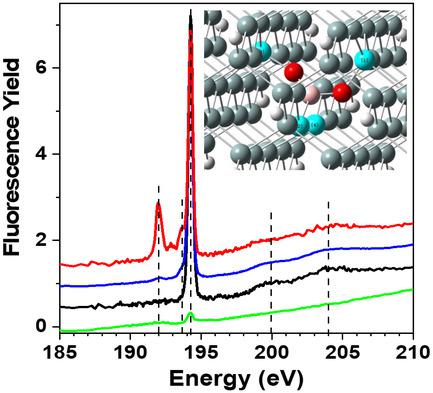当前位置:
X-MOL 学术
›
Phys. Status Solidi B
›
论文详情
Our official English website, www.x-mol.net, welcomes your feedback! (Note: you will need to create a separate account there.)
On the Location of Boron in SiO2-Embedded Si Nanocrystals—An X-ray Absorption Spectroscopy and Density Functional Theory Study
Physica Status Solidi (B) - Basic Solid State Physics ( IF 1.6 ) Pub Date : 2021-03-24 , DOI: 10.1002/pssb.202000623 Daniel Hiller 1, 2 , Dirk König 3, 4 , Peter Nagel 5 , Michael Merz 5 , Stefan Schuppler 5 , Sean C. Smith 3, 6
Physica Status Solidi (B) - Basic Solid State Physics ( IF 1.6 ) Pub Date : 2021-03-24 , DOI: 10.1002/pssb.202000623 Daniel Hiller 1, 2 , Dirk König 3, 4 , Peter Nagel 5 , Michael Merz 5 , Stefan Schuppler 5 , Sean C. Smith 3, 6
Affiliation

|
Doping of silicon nanostructures is crucial to understand their properties and to enhance their potential in various fields of application. Herein, SiO2-embedded Si nanocrystals (quantum dots) ≈3–6 nm in diameter are used as a model system to study the incorporation of B dopants by X-ray absorption near-edge spectroscopy (XANES). Such samples represent a model system for ultimately scaled, 3D-confined Si nanovolumes. The analysis is complemented by real-space density functional theory to calculate the 1s (K shell) electron binding energies of B in 11 different, thermodynamically stable configurations of the Si/SiOx/SiO2 system. Although no indications for a substitutional B-acceptor configuration are found, the predominant O coordination of B indicates the preferred B incorporation into the SiO2 matrix and near the Si-nanocrystal/SiO2 interface, which is inherently incompatible with charge carrier generation by dopants. It is concluded that B doping of ultrasmall Si nanostructures fails due to a lack of B incorporation onto Si lattice sites that cannot be overcome by increasing the B concentration. The inability to efficiently insert B into Si nanovolumes appears to be a boron-specific fundamental obstacle for electronic doping (e.g., not observed for phosphorus) that adds to the established nanosize effects, namely, increased dopant activation and ionization energies.
中文翻译:

SiO2嵌入Si纳米晶中硼的位置——X射线吸收光谱和密度泛函理论研究
硅纳米结构的掺杂对于了解它们的特性和提高它们在各个应用领域的潜力至关重要。在此,SiO 2嵌入的Si纳米晶体(量子点)直径≈3-6 nm用作模型系统,通过X射线吸收近边光谱(XANES)研究B掺杂剂的掺入。这些样品代表了最终缩放的、3D 限制的 Si 纳米体积的模型系统。该分析辅以实空间密度泛函理论,以计算Si/SiO x /SiO 2 的11 种不同热力学稳定构型中 B的 1 s(K 壳层)电子结合能系统。虽然没有发现替代 B 受体构型的迹象,但 B 的主要 O 配位表明 B 优先掺入 SiO 2基质中并靠近 Si-纳米晶体/SiO 2界面,这与掺杂剂产生的电荷载流子本质上不相容. 得出的结论是,超小硅纳米结构的硼掺杂失败是由于缺乏硼掺入硅晶格位点,这无法通过增加硼浓度来克服。无法有效地将 B 插入 Si 纳米体积似乎是硼特定的电子掺杂的基本障碍(例如,未观察到磷),这增加了已建立的纳米尺寸效应,即增加掺杂剂活化和电离能。
更新日期:2021-03-24
中文翻译:

SiO2嵌入Si纳米晶中硼的位置——X射线吸收光谱和密度泛函理论研究
硅纳米结构的掺杂对于了解它们的特性和提高它们在各个应用领域的潜力至关重要。在此,SiO 2嵌入的Si纳米晶体(量子点)直径≈3-6 nm用作模型系统,通过X射线吸收近边光谱(XANES)研究B掺杂剂的掺入。这些样品代表了最终缩放的、3D 限制的 Si 纳米体积的模型系统。该分析辅以实空间密度泛函理论,以计算Si/SiO x /SiO 2 的11 种不同热力学稳定构型中 B的 1 s(K 壳层)电子结合能系统。虽然没有发现替代 B 受体构型的迹象,但 B 的主要 O 配位表明 B 优先掺入 SiO 2基质中并靠近 Si-纳米晶体/SiO 2界面,这与掺杂剂产生的电荷载流子本质上不相容. 得出的结论是,超小硅纳米结构的硼掺杂失败是由于缺乏硼掺入硅晶格位点,这无法通过增加硼浓度来克服。无法有效地将 B 插入 Si 纳米体积似乎是硼特定的电子掺杂的基本障碍(例如,未观察到磷),这增加了已建立的纳米尺寸效应,即增加掺杂剂活化和电离能。



























 京公网安备 11010802027423号
京公网安备 11010802027423号